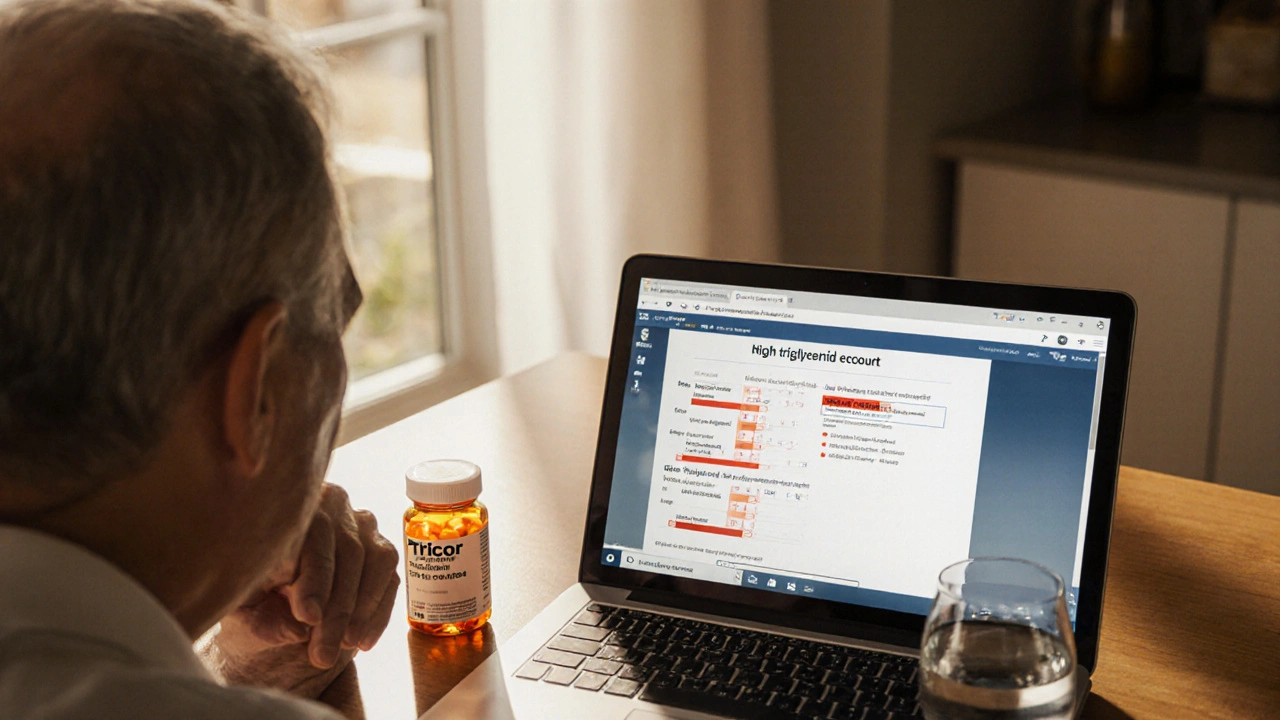Lipid-Lowering Drug Comparison Tool
Select Your Priority Areas
Choose which factors matter most to you when selecting a lipid-lowering medication.
Recommended Medication for You
Detailed Comparison
If you’ve been prescribed Tricor (fenofibrate) to tame high triglycerides, you’re probably wondering whether there’s a better or cheaper option. fenofibrate belongs to the fibrate family, drugs that primarily lower triglycerides and raise “good” HDL cholesterol. In South Africa the brand name Tricor is the most common way patients receive fenofibrate, but the molecule itself is sold under many generics worldwide. This article lines up Tricor against the most frequently prescribed alternatives - statins, ezetimibe, omega‑3 fatty acids and niacin - so you can see where it shines, where it falls short, and which factors matter most when you and your doctor choose a lipid‑lowering plan.
Key Takeaways
- Tricor (fenofibrate) is best at cutting triglycerides but does little for LDL cholesterol.
- Statins (atorvastatin, rosuvastatin, simvastatin) are superior at lowering LDL and reducing overall cardiovascular risk.
- Ezetimibe adds extra LDL reduction when combined with a statin, with minimal muscle side‑effects.
- Omega‑3 supplements lower TG modestly and are well‑tolerated, but are pricier.
- Niacin can raise HDL and lower TG, yet flushing and liver concerns limit its use.
What is Tricor (fenofibrate) and when is it used?
Tricor is the commercial name for the drug fenofibrate, a prescription medication approved by the FDA in 1998 for treating hypertriglyceridaemia. It is indicated for patients with triglyceride levels above 5mmol/L (≈440mg/dL) who are at risk of pancreatitis, or for those whose LDL‑cholesterol is already controlled by a statin but still have high TG. In South Africa it is prescribed under the National Health Insurance scheme and is also available as a generic powder.
How fenofibrate lowers triglycerides
Fenofibrate activates the nuclear receptor PPAR‑α (peroxisome proliferator‑activated receptor‑alpha). This switches on genes that increase fatty‑acid oxidation, enhance lipoprotein lipase activity, and reduce hepatic production of VLDL particles. The net effect is a 30‑50% drop in triglycerides and a 5‑15% rise in HDL‑cholesterol. Unlike statins, fenofibrate has only a modest impact on LDL‑cholesterol (usually a 5‑10% reduction).
How we compare lipid‑lowering drugs
To make a fair side‑by‑side look, we weigh each medication on six criteria that matter to most patients and clinicians:
- Triglyceride reduction - % drop from baseline.
- LDL‑cholesterol lowering - % drop; key driver of cardiovascular outcomes.
- HDL‑cholesterol effect - % rise.
- Proven cardiovascular benefit - outcomes data from large trials.
- Safety & tolerability - common side‑effects and drug interactions.
- Cost & availability in South Africa (2025).
Statins - the LDL‑focused giants
Statins inhibit HMG‑CoA reductase, the rate‑limiting step in cholesterol synthesis. They are the first‑line choice for anyone with elevated LDL or established heart disease.
Atorvastatin (Lipitor) is a high‑potency statin that can shave 50‑60% off LDL at a 80mg dose. Rosuvastatin (Crestor) is similarly potent but often better tolerated at lower doses. Simvastatin (Zocor) is older, cheaper, and works well for moderate LDL reductions.

Ezetimibe - the cholesterol absorption blocker
Ezetimibe targets the NPC1L1 transporter in the small intestine, cutting dietary cholesterol uptake by about 15‑20%. It is typically added to a statin when LDL remains above target. Alone, it drops LDL 15‑20% with virtually no effect on triglycerides.
Omega‑3 fatty acids (EPA/DHA) - natural TG reducers
Omega‑3 fatty acids (prescription‑grade EPA/DHA) lower triglycerides by 20‑30% and modestly raise HDL. They work through reduced hepatic VLDL synthesis and improved clearance. Muscle pain is rare, but the biggest downside is price, especially for the brand‑name Vascepa®.
Niacin - the old‑school HDL booster
Niacin (vitaminB3) can raise HDL by up to 30% and cut triglycerides 20‑25%. However, flushing, itching, and potential liver toxicity have pushed it out of first‑line therapy in most guidelines.
Cost snapshot (2025, South Africa)
| Drug | Class | Typical dose | Triglyceride ↓ | LDL ↓ | Common side‑effects | Monthly cost (ZAR) |
|---|---|---|---|---|---|---|
| Tricor (fenofibrate) | Fibrate | 145mg PO daily | 30‑50% | 5‑10% | GI upset, ↑ liver enzymes | ≈300 |
| Atorvastatin | Statin | 10‑80mg PO daily | 5‑15% | 50‑60% | Muscle aches, ↑ liver enzymes | ≈250 |
| Rosuvastatin | Statin | 5‑40mg PO daily | 5‑15% | 45‑55% | Muscle aches, rare rhabdo | ≈300 |
| Ezetimibe | Absorption inhibitor | 10mg PO daily | ~0% | 15‑20% | Diarrhoea, fatigue | ≈350 |
| Omega‑3 (EPA/DHA) | Fish‑oil derivative | 2‑4g PO daily | 20‑30% | ~5% | Fishy after‑taste, mild GI | ≈500 |
| Niacin | Vitamin B3 | 500‑1000mg PO daily | 20‑25% | ~5% | Flushing, itching, liver risk | ≈150 |
How to decide which drug fits you
Use the following quick‑check to narrow down the best option:
- If your primary problem is very high triglycerides (>5mmol/L) **and** you have no major liver or kidney issues, start with fenofibrate (Tricor).
- If LDL‑cholesterol is above 3mmol/L (115mg/dL) or you have established cardiovascular disease, a statin should be first‑line.
- When a statin alone doesn’t hit LDL targets, add ezetimibe for extra 15‑20% reduction.
- If statins are not tolerated (muscle pain) but you still need LDL control, consider switching to a different statin or add a fibrate carefully under monitoring.
- For modest TG elevation (2‑5mmol/L) and a desire for a “natural” option, EPA/DHA fish‑oil can be added to a statin or fibrate regimen.
- Only consider niacin if you specifically need HDL boost and can tolerate flushing, and always monitor liver function.
Always discuss these choices with your doctor, who will factor in your full lipid panel, other meds, kidney function, and personal cost preferences.
Frequently Asked Questions
Can I take Tricor and a statin together?
Yes, many doctors combine a fibrate with a low‑to‑moderate potency statin when both high triglycerides and high LDL need treatment. Monitoring liver enzymes and muscle enzymes is essential.
Which drug lowers triglycerides the most?
Fenofibrate (Tricor) typically reduces TG by 30‑50%, which is higher than statins (5‑15%) and similar to high‑dose EPA/DHA fish‑oil (20‑30%).
Is fenofibrate safe for people with diabetes?
Generally yes. Fenofibrate does not significantly affect blood glucose, but it can raise serum creatinine, so kidney function should be checked regularly.
Why do some patients experience muscle pain with statins but not with fenofibrate?
Statins inhibit cholesterol synthesis in muscle cells, which can lead to myopathy in susceptible individuals. Fenofibrate works through a different pathway (PPAR‑α), so the muscle‑related side‑effect profile is lower.
Are there any food restrictions while on Tricor?
No strict restrictions, but a low‑fat, balanced diet helps the drug work faster and reduces the chance of stomach upset.





Sadie Speid
October 3, 2025 AT 06:24Hey everyone, if you’re wrestling with sky‑high triglycerides, remember that consistency and lifestyle tweaks can amplify the power of Tricor. Stick to your prescribed dose, pair it with a low‑fat diet, and keep moving – the results will speak for themselves!
Sue Ross
October 10, 2025 AT 05:04I appreciate the thorough breakdown of each class. It’s helpful to see the numbers side‑by‑side so patients can weigh triglyceride reduction against LDL impact and cost. This kind of clear presentation really aids shared decision‑making.
Rohinii Pradhan
October 17, 2025 AT 03:44From a pharmacological perspective, fenofibrate’s mechanism of action via PPAR‑α activation distinguishes it from statins, which inhibit HMG‑CoA reductase. Consequently, fenofibrate drives a pronounced catabolism of very‑low‑density lipoproteins, yielding a 30‑50% reduction in serum triglycerides.
In contrast, statins achieve LDL‑cholesterol reductions of 45‑60% but exert only modest effects on triglycerides, typically 5‑15%.
Clinical trials such as FIELD and ACCORD have demonstrated that fibrates modestly lower cardiovascular events in patients with marked hypertriglyceridaemia, particularly when baseline TG exceeds 5 mmol/L.
However, the absolute risk reduction remains smaller than that observed with high‑intensity statin therapy in primary prevention cohorts.
Safety profiles also diverge: fenofibrate is associated primarily with gastrointestinal discomfort and transient elevations in hepatic transaminases, whereas statins carry a risk of myopathy and, rarely, rhabdomyolysis.
Renal considerations are paramount; fenofibrate can increase serum creatinine, necessitating periodic monitoring, especially in patients with pre‑existing kidney disease.
Cost analyses in South Africa reveal that fenofibrate (≈R300/month) is comparable to generic statins (≈R250‑R300/month) but remains more expensive than niacin (≈R150/month).
Nonetheless, niacin’s adverse effect profile-flushing, pruritus, potential hepatotoxicity-limits its tolerability for many patients.
Omega‑3 fatty acid preparations, while effective at reducing triglycerides by 20‑30%, are substantially pricier (≈R500/month) and often require high daily doses to achieve therapeutic plasma levels.
Ezetimibe, with minimal impact on triglycerides, serves best as an adjunct to statins for incremental LDL lowering, offering a modest 15‑20% reduction.
Guideline‑driven therapy thus recommends reserving fibrates for individuals whose primary dyslipidaemia is hypertriglyceridaemia, especially when levels exceed 5 mmol/L and the risk of pancreatitis is imminent.
In patients with mixed dyslipidaemia, combination therapy-low‑to‑moderate intensity statin plus fenofibrate-may be employed, but careful monitoring for hepatic and muscular adverse events is essential.
Finally, patient preference and tolerability should guide the ultimate choice; some may prioritize the dramatic triglyceride cut offered by fenofibrate, while others may favour the proven cardiovascular mortality benefit of statins.
Anna-Lisa Hagley
October 21, 2025 AT 18:51While the chart looks neat, real‑world adherence often crumbles under the weight of polypharmacy, especially when patients are asked to juggle statins, fibrates, and fish‑oil capsules simultaneously.
A Walton Smith
October 25, 2025 AT 06:11Just another expense.
Theunis Oliphant
October 28, 2025 AT 16:31One must concede that the erudite presentation of data, whilst aesthetically pleasing, masks the stark reality that many patients will simply opt for the cheapest remedy, irrespective of nuanced efficacy differentials.
India Digerida Para Occidente
October 31, 2025 AT 00:04Indeed, the economic calculus cannot be ignored; however, for those with severe hypertriglyceridaemia, the therapeutic gain from fenofibrate may well justify the modest premium, provided vigilant monitoring is in place.
Andrew Stevenson
November 3, 2025 AT 11:24Great overview! From a clinical workflow standpoint, integrating the tool into EMR portals could streamline patient‑specific prioritization, letting clinicians swiftly toggle between TG‑centric and LDL‑centric algorithms.
Kate Taylor
November 5, 2025 AT 18:58Absolutely, the decision‑support model aligns nicely with precision medicine goals. Just remember to counsel patients about potential GI upset with fenofibrate and the importance of periodic LFTs.
Hannah Mae
November 9, 2025 AT 06:18i think statins are overrated, most ppl get fine with just diet and exercise lol
Iván Cañas
November 11, 2025 AT 13:51While lifestyle mods are foundational, meta‑analyses consistently demonstrate that statins reduce major adverse cardiovascular events by roughly 25% in primary prevention-an impact diet alone seldom matches.
Jen Basay
November 15, 2025 AT 01:11Interesting read! 😊 I think the comparison chart makes it easier to explain options to patients during consults.
Hannah M
November 17, 2025 AT 08:44Totally agree! 👍 The visual aid is a game‑changer for shared decision‑making.
Poorni Joth
November 20, 2025 AT 20:04Idk why anyone would even consider fenofibrate when you can just pop niacin and deal with the damn flushing – cheaper and you get that HDL boost!
Yareli Gonzalez
November 23, 2025 AT 03:38Flushing can be mitigated by dose titration and taking niacin with meals; however, the risk‑benefit balance still favours fibrates for patients with markedly elevated triglycerides.
Alisa Hayes
November 26, 2025 AT 14:58Both points are valid – niacin offers a quick HDL surge but fenofibrate delivers the most robust triglyceride cut. Ultimately, the choice hinges on individual lipid profiles, tolerability, and cost considerations.